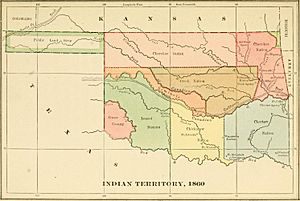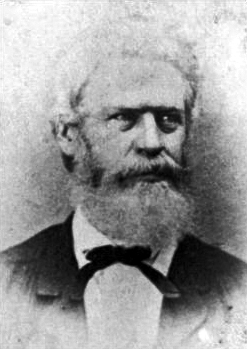Indian Territory in the American Civil War facts for kids
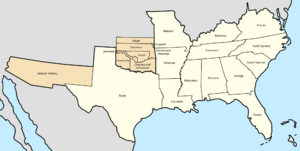
During the American Civil War, much of what is now Oklahoma was called the Indian Territory. This was a special area set aside for Native American tribes. Many tribes had been forced to move there from their homes in the Southeastern United States after the Indian Removal Act of 1830.
The Indian Territory became a battlefield during the war. It saw many small fights and seven major battles. Both Native American groups who sided with the Confederate States of America and those loyal to the United States government fought here. Other Union and Confederate soldiers also joined the fighting.
More than 7,860 Native Americans from the Indian Territory joined the Confederate Army. Most of these soldiers came from the Five Civilized Tribes. These tribes were the Cherokee, Chickasaw, Choctaw, Creek, and Seminole nations. The Union also formed groups called the Indian Home Guard. These groups fought in the Indian Territory and nearby areas like Kansas, Missouri, and Arkansas.
Contents
Native American Alliances in the Civil War
Before the war began, the United States government moved all its soldiers out of the Indian Territory. This left the area open to attacks from Texas and Arkansas, which had joined the Confederacy. The Confederacy was interested in the territory for a few reasons. They wanted it as a possible food source if the Union blocked their supplies. They also saw it as a link to western lands and a protective barrier for Texas against Union-held Kansas.
When the war started, Confederate forces took over the U.S. army forts in the territory. In the summer of 1861, Confederate officers talked with Native American tribes. They wanted the tribes to help them fight. However, the Creek Principal Chief Opothleyahola refused to let Creek lands become part of the Confederacy. He led Creek people who supported the Union to Kansas. They had to fight battles along the way.
Leaders from each of the Five Civilized Tribes eventually agreed to join the Confederacy. They did this without getting approval from their tribal councils. In return, they were promised protection and that their tribal lands would be recognized.
After reaching Kansas and Missouri, Opothleyahola and other Native Americans loyal to the Union formed three volunteer groups. These were known as the Indian Home Guard. They fought in the Indian Territory and Arkansas.
The following Native American Nations signed treaties to become allies with the Confederacy:
- Cherokee Nation
- Chickasaw Nation
- Choctaw Nation
- Creek Nation
- Seminole Nation
- Comanche Nation
- Osage Nation
- Quapaw Nation
- Seneca–Cayuga Nation
- Shawnee Nation
Challenges for the Union Army
The Union Army left its forts in the Indian Territory early in the Civil War. Later, it was hard for them to take control back from the Confederates. The area was not well-developed. Roads were few and rough, and there were no railroads yet.
Native Americans who supported the Union had left their farms. They fled to Kansas or Missouri to find safety with Union forces. The Union Army did not have enough soldiers to control the few roads. It was also hard to keep a large army supplied by living off the land. This problem was clear in 1862. General William Weer's "Indian Expedition" into the territory failed. His troops quickly ran out of food and supplies.
Key Military Actions
The first battle in the territory happened on November 19, 1861. Chief Opothleyahola gathered 7,000 men, women, and children who supported the Union. They set up camp near the Deep Fork. A Confederate force of 1,400 soldiers, led by Colonel Douglas H. Cooper, attacked them. This was the Battle of Round Mountain. The Confederates were pushed back and defeated.
Opothleyahola then moved his camp to Chustenalah. On December 26, 1861, Confederate forces attacked again. This time, they forced Opothleyahola and his people to flee to Kansas during a snowstorm.
The Union won a major victory at the Battle of Pea Ridge in northwest Arkansas in March 1862. This win helped the Union control Arkansas and Missouri. It also made it harder for the Confederate government to help its Native American allies. Stand Watie, a Cherokee leader who fought at Pea Ridge, and other Confederate officers in the Indian Territory had to continue fighting without much support.
The Union army took back its forts in the territory. But they had to leave them again temporarily because of ongoing raids by Stand Watie. Later, the Union recaptured the forts once more. Stand Watie was the last Confederate commander in the field to surrender.
Indian Expedition of 1862

In 1862, Union General James G. Blunt sent Colonel William Weer on an expedition into the Indian Territory. This group included over 5,000 men. There were five white regiments, two Native American regiments, and two artillery groups. The main goal was to bring Native American refugees from Kansas back to their homes. Another goal was to hold the territory for the Union.
Weer's expedition started from Baxter Springs, Kansas. They had early success at the Battle of Locust Grove on July 3. The expedition camped at Locust Grove for two weeks. They waited for a Union supply train that never arrived. Food, animal feed, and ammunition started to run out. Weer was unsure what to do next. His men eventually rebelled. They arrested Weer and put Colonel Frederick Salomon in charge. This ended the expedition. However, the expedition did encourage the formation of three Indian Home Guard regiments for the Union.
First Battle of Cabin Creek
Two battles took place at the Cabin Creek Battlefield in the Cherokee Nation. This spot was where the Texas Road crossed Cabin Creek. It was near the town of Big Cabin, Oklahoma. Both the First and Second Battles of Cabin Creek were Confederate attempts to stop Union supply trains. These trains were going from Fort Scott to Fort Gibson.
The First Battle of Cabin Creek happened on July 1–2, 1863. Colonel James Monroe Williams led the Union escort. He was warned about the attack. Even though the creek was swollen from rain, Williams launched a successful counterattack. He forced the Confederates to flee. This battle was important because African-American troops fought alongside white soldiers for the first time.
Battle of Honey Springs
Honey Springs Depot was a place where many small fights happened. General James G. Blunt chose it as the spot to fight the largest Confederate forces in Indian Territory. Blunt thought that Confederate General Douglas H. Cooper would try to join forces with General William Cabell. Cabell was moving to attack Fort Gibson.
On July 17, 1863, Blunt approached Honey Springs with 3,000 men. His force included Native Americans and African-American former slaves. That morning, he fought Cooper in the Battle of Honey Springs. Cooper commanded 3,000 to 6,000 men, mostly Native Americans. Cooper's troops became disorganized and retreated. Their gunpowder got wet, causing misfires, and rain made it hard to move. This was the biggest battle of the war in the Indian Territory. After this Union victory, guerrilla warfare became the main type of fighting in the territory.
Battle of Perryville
Perryville was a town on the Texas Road. It became a major supply center for the Confederate army. After the Battle of Honey Springs, General Cooper retreated to Perryville to get more supplies. General Blunt, who had returned to Fort Gibson, learned that the Confederates had regrouped there. He believed his troops could capture the depot and destroy Cooper's forces.
Blunt gathered his forces and went to Perryville. He arrived on August 23, 1863. He found that the Confederate commanders, Cooper and Watie, had already left. Only a small group, led by Brigadier General William Steele, remained. Blunt attacked at night. The two sides exchanged cannon fire. Union forces quickly scattered the Confederates. They retreated again, leaving their supplies behind. Blunt's forces took what they could use and then burned the town. Instead of chasing the Confederates, Blunt attacked Fort Smith. He captured it on September 1, 1863.
Battle of Middle Boggy
On February 13, 1864, about 350 Union troops attacked a Confederate outpost. The outpost was guarded by about 90 poorly armed Confederate soldiers. It was located where the Dragoon Road crossed the Middle Boggy River. The Confederates fought back for about half an hour. Then they fled on foot toward Fort Washita.
The Union Army claimed victory because 49 Confederates were killed, while the Union forces had no deaths. This fight did not change the overall outcome of the Civil War. It was the last important skirmish of the war in Indian Territory. Even though it was a defeat for the Confederates, the way Union troops treated civilians and wounded soldiers made the Confederates even more determined to keep fighting.
Second Battle of Cabin Creek
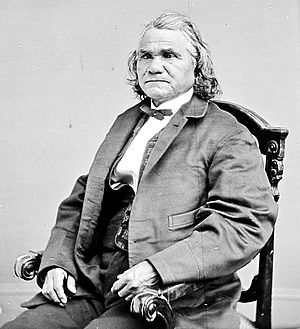
The Second Battle of Cabin Creek was part of a plan by Confederate Brigadier General Stand Watie. He had been promoted after the First Battle of Cabin Creek. Watie's plan was for a Confederate force to attack central Kansas from Indian Territory. They would raid Union Army bases and encourage Native American tribes in western Kansas to join them. Watie presented his plan to his superior, General Samuel B. Maxey, on February 5, 1864. Maxey approved the plan. The attack was to start by October 1. This would happen at the same time as an attack on Missouri planned by General Sterling Price.
Guerrilla Warfare in the Territory
From 1864 until the summer of 1865, fighting in the Indian Territory mostly involved guerrilla warfare. This means small groups of fighters used surprise attacks. Confederate Colonel William Quantrill and his group carried out many raids. They stole horses and cattle. They also burned down communities of both Confederate and Union supporters.
Another type of fighter was the Confederate Army unit led by General Stand Watie. His group only attacked military targets. They destroyed houses and barns that Union troops used as headquarters or for storing supplies. Watie also targeted military supply trains. This not only took away supplies from Union troops but also gave his men valuable goods. One of Watie's biggest successes was the ambush of the steamboat J.R. Williams in September 1864. Watie surrendered with his troops at Doaksville on June 23, 1865.
After the War
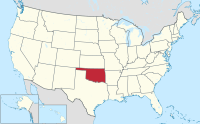

At Fort Towson in Choctaw lands, General Stand Watie officially became the last Confederate general to surrender. This happened on June 25, 1865. Watie later went to Washington, D.C., to talk for his tribe. He was the main chief of the pro-Confederacy group elected in 1862. He wanted the U.S. government to recognize a Southern Cherokee Nation. He did not return home until May 1866.
The U.S. government only negotiated with the Cherokee who had supported the Union. They named John Ross as the rightful principal chief. Ross had gone into hiding in 1862 when most of the tribe supported the Confederacy.
As part of the Reconstruction Treaties, U.S. officials forced the tribes to give up some land. They also required the Cherokee and other tribes to free their slaves. These formerly enslaved people were to be given full rights as members of their tribes. This included rights to payments and land. The Southern Cherokee had wanted the U.S. government to pay to move the Cherokee Freedmen away from the tribe. Later, the issue of citizenship caused problems when Native American lands were divided among households. This happened under the Dawes Commission. In the early 1900s, the Cherokee Nation voted to exclude the Freedmen from the tribe. This was unless they also had a direct ancestor who was Cherokee (not just a Cherokee Freedman) listed on the Dawes Rolls (1902–1906).


